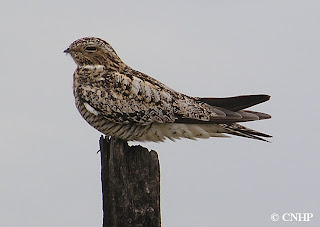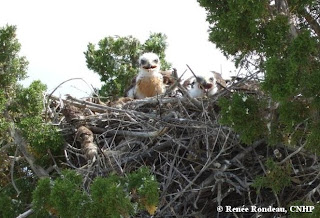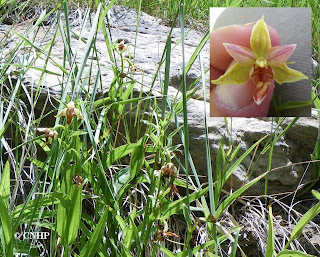Dave Anderson, Joe Stevens, and Jessica Parker recorded the first known occurrence of the giant hellborine orchid (Epipactis gigantea) from southeast Colorado, in Las Animas County. This is the first record of this species anywhere on the plains of Colorado - the next nearest occurrence is in Chaffee County, well over 100 miles away! This tall perennial orchid grows from creeping rhizomes, and requires a constant source of water at its roots. The tall stems with reddish flowers in the leaf axils make this species one of Colorado's most distinctive orchids.
While CNHP staff were documenting the orchid in southeastern Colorado, our friend and fellow botany enthusiast Annette Miller was re-discovering a small population of the plant in the opposite corner of the state, while on a raft trip through Dinosaur National Monument. Sue Ellen Campbell took this photo of the Moffat county occurrence:
Thursday, July 30, 2009
Tuesday, July 28, 2009
Swift fox - Vulpes velox

This small fox occurs in the Great Plains of North America, from Texas into southern Canada, including Colorado’s eastern plains. It is usually associated with shortgrass and mixed-grass prairie ecosystems, but can also be found in sagebrush and agricultural fields or fencerows. Suitable soil for digging dens is a critical requirement.
Historically, swift fox populations were decimated by trapping, shooting, and poisoning, though populations began to recover in the 1950s. Current threats to this species include habitat loss and degradation through urban development and conversion to agriculture, competition with coyotes, and poisoning of prey species. The swift fox is considered Globally Vulnerable (G3) because its range has shrunk by more than half and its long-term population trend has experienced a substantial decline.
Thursday, July 23, 2009
Statewide Strategies for Colorado Wetlands
by Joanna Lemly, CNHP Wetland Ecologist
Statewide Strategies for Colorado Wetlands is a collaborative effort by CNHP and the Colorado Division of Wildlife’s Wetlands Program that aims to determine the types, abundance, threats to, and level of protection currently provided to Colorado’s wetlands and to initiate the process of assessing their ecological condition. The outcome of these efforts will be the development of a statewide strategy for protecting and restoring wetlands in Colorado for the benefit of wetland-dependent wildlife.
This project pulls together existing geospatial data for wetlands in Colorado to establish a single, standardized, centralized database that contains the current knowledge of wetlands in Colorado and will make this data available via the web to wetland conservation partners statewide. Digital spatial data for wetlands are currently being compiled, and existing paper maps from the National Wetlands Inventory have been scanned and digitized for the Rio Grande Headwaters and North Platte river basin, adding new digital spatial data that were previously unavailable.
In addition, this project will begin to assess the ecological condition of Colorado’s wetlands by carrying out a pilot wetland condition assessment in the Rio Grande Headwaters river basin. As part of the pilot assessment, over 115 wetlands were surveyed during the summer of 2008 and an additional 60 sites are currently being surveyed during the 2009 field season.
For more information on wetlands assessment, see our 2009 report "Vegetation Index of Biotic Integrity (VIBI) for Headwater Wetlands in the Southern Rocky Mountains" (9.7 Mb pdf) or search our website for previous wetlands reports.
Statewide Strategies for Colorado Wetlands is a collaborative effort by CNHP and the Colorado Division of Wildlife’s Wetlands Program that aims to determine the types, abundance, threats to, and level of protection currently provided to Colorado’s wetlands and to initiate the process of assessing their ecological condition. The outcome of these efforts will be the development of a statewide strategy for protecting and restoring wetlands in Colorado for the benefit of wetland-dependent wildlife.
This project pulls together existing geospatial data for wetlands in Colorado to establish a single, standardized, centralized database that contains the current knowledge of wetlands in Colorado and will make this data available via the web to wetland conservation partners statewide. Digital spatial data for wetlands are currently being compiled, and existing paper maps from the National Wetlands Inventory have been scanned and digitized for the Rio Grande Headwaters and North Platte river basin, adding new digital spatial data that were previously unavailable.
In addition, this project will begin to assess the ecological condition of Colorado’s wetlands by carrying out a pilot wetland condition assessment in the Rio Grande Headwaters river basin. As part of the pilot assessment, over 115 wetlands were surveyed during the summer of 2008 and an additional 60 sites are currently being surveyed during the 2009 field season.
For more information on wetlands assessment, see our 2009 report "Vegetation Index of Biotic Integrity (VIBI) for Headwater Wetlands in the Southern Rocky Mountains" (9.7 Mb pdf) or search our website for previous wetlands reports.
Tuesday, July 21, 2009
CNHP Ecologist leads tour of Hanna Ranch
CNHP Ecologist Renée Rondeau led a tour last Wednesday of the Hanna Ranch, south of Colorado Springs. The owners of the ranch are working on a conservation easement with the help of the Colorado Conservation Partnership to set aside approximately 460 acres along Fountain Creek.
Renée led potential supporters and journalists on a hike through the ranch's riparian communities. The tour emphasized the need to conserve large landscapes that connect our high peaks with our prairie systems. By participating in such events, CNHP is assisting with landscape conservation by sharing our conservation knowledge with those that have the resources to pursue on-the-ground conservation.
Read the related articles in The Pueblo Chieftain and Colorado Springs Gazette.
Renée led potential supporters and journalists on a hike through the ranch's riparian communities. The tour emphasized the need to conserve large landscapes that connect our high peaks with our prairie systems. By participating in such events, CNHP is assisting with landscape conservation by sharing our conservation knowledge with those that have the resources to pursue on-the-ground conservation.
Read the related articles in The Pueblo Chieftain and Colorado Springs Gazette.
Thursday, July 16, 2009
Vegetation mapping and collection at Great Sand Dunes
Field crews headed by CNHP Ecologist Joe Stevens have been working since 2005 at the Great Sand Dunes National Park and Preserve to classify and map the diverse vegetation of the Park as well as to collect and identify all known plant species within the Park.
The Great Sand Dunes National Park and Preserve showcases a wide range of ecosystems on a steep elevational gradient, going from dunes, shrublands, lakes and wetlands on the valley floor (7,550 feet elevation) through montane and subalpine forest, to alpine tundra at over 13,000 feet in the space of just three or four miles. The project area boundary encompasses 413,000 acres.
The vegetation mapping project is in collaboration with the National Park Service, U.S. Fish and Wildlife Service, U.S. Forest Service, U.S. Bureau of Reclamation, U.S. Geological Service, NatureServe, and The Nature Conservancy. The project is wrapping up this summer and will result in a detailed map of the area’s vegetation, descriptions of all the classified types, and a field key to the vegetation, representing approximately 200 different plant associations.
For the plant species collection project, CNHP assisted the Great Sand Dunes staff to identify vascular plant species within the Park, and to collect over 700 voucher specimens for the Park herbarium. A state-rare sedge, slender sedge (Carex lasiocarpa, G5S1) was documented, as well as western bitterweed (Rydbergia (Tetraneuris) brandegeei), a regional endemic found only in the Sangre DeCristo mountains in Colorado.
Tuesday, July 14, 2009
More field updates from Southeast Colorado
Denise Culver and Jodie Bell from the CNHP Ecology Team conducted a biological inventory in late June on a private ranch in SE Colorado. The ranch was ~22,000 acres and housed several rare species. We documented beautiful examples of sand sage plant communities, prairie dog towns with burrowing owls, ponds teeming with painted turtles and Northern leopard frogs, the rare sandhill goosefoot (Chenopodium cycloides), and plains ragweed (Ambrosia linearis).





We were lucky enough to have Triston, a 7 year old ranch-hand, to assist us with dip-netting ponds and diving through mud chasing after leaping leopard frogs. Thanks Triston!



Nice example of a sand sage prairie with pink plains penstemon (Penstemon ambiguus).

A lesser earless lizard (Holbrookia maculata) taking a rest to pose for us.

Northern leopard frog (Rana pipiens), a watchlisted species.

Common nighthawks (Chordeiles minor) were certainly common along the fence posts.

Denise keying out a rare ragweed, Ambrosia linearis.
We were lucky enough to have Triston, a 7 year old ranch-hand, to assist us with dip-netting ponds and diving through mud chasing after leaping leopard frogs. Thanks Triston!

Thanks to Triston’s quick reflexes we catch a Northern leopard frog.

Jodie and Triston searching the wetlands for amphibians and reptiles.
Thursday, July 9, 2009
Our new and improved website is here!
We have completely revised and updated our website with new and updated content, a sleek new look, and improved navigation, among other features. This overhaul has been a long time in coming and we hope you are as excited about the improvements as we are.
Like all websites, it is a dynamic work in progress and additional functionality, such as searchable reports, an online ER data request form, and a user feedback form will be forthcoming. But there is plenty of good stuff to look at now. Please let us know what you think!
Like all websites, it is a dynamic work in progress and additional functionality, such as searchable reports, an online ER data request form, and a user feedback form will be forthcoming. But there is plenty of good stuff to look at now. Please let us know what you think!
Tuesday, July 7, 2009
Biodiversity from the Cretaceous to the present in SE Colorado
by Renée Rondeau, CNHP, and Dina Clark, Denver Botanic Gardens
This is the second year of the Colorado Natural Heritage Program's Southeast Colorado inventory, and we continue to discover the biological significance of private ranches in the area.
CNHP is surveying for rare plants, animals, and plant communities in the area and access generously granted by private landowners to at least 300,000 acres in SE Colorado has allowed CNHP to document the ecological significance that these native landscapes continue to support. Funding for this project is from Great Outdoors Colorado, Colorado Division of Wildlife, Colorado Cattleman’s Agricultural Land Trust, and private landowners.
In just a single day on one ranch we located 15 species of conservation concern, all with populations in excellent condition.

On another day in a different area we discovered evidence of the biodiversity of long ago.

These areas may have been biologically significant since the Cretaceous period (between 65 and 136 million years ago). The ancient shallow seas of those times supported a rich marine life complete with many types of ammonites, bivalves, sharks, and more. Today the fossilized seabeds form mesas, buttes, bluffs, and escarpments that are just as important to modern species, creating a distinct habitat that is critical for rare plants, animals, and plant communities. These sites are also rich in unusual geologic specimens, such as concretions filled with calcite crystals or others that resemble petrified wood.


Today these buttes, bluffs, and escarpments are just as important to modern species, creating a distinct habitat that is critical for rare plants, animals, and plant communities.

In sharp contrast to the surrounding shortgrass prairie, these juniper breaks are populated with short trees and shrubs that provide important wildlife and livestock habitat, especially during winter storms.


We thank all of the landowners, partners, and all of our volunteers and interns for making this a success. Summer has just started so stay tuned for new discoveries!

This is the second year of the Colorado Natural Heritage Program's Southeast Colorado inventory, and we continue to discover the biological significance of private ranches in the area.
CNHP is surveying for rare plants, animals, and plant communities in the area and access generously granted by private landowners to at least 300,000 acres in SE Colorado has allowed CNHP to document the ecological significance that these native landscapes continue to support. Funding for this project is from Great Outdoors Colorado, Colorado Division of Wildlife, Colorado Cattleman’s Agricultural Land Trust, and private landowners.
In just a single day on one ranch we located 15 species of conservation concern, all with populations in excellent condition.

Echinocereus reichenbachii (Reichenbach's Hedgehog Cactus)
On another day in a different area we discovered evidence of the biodiversity of long ago.

Fossils such as this ammonite can be found in the area
 A close-up of a calcite crystal filled concretion
A close-up of a calcite crystal filled concretion
 A close-up of a calcite crystal filled concretion
A close-up of a calcite crystal filled concretionThese areas may have been biologically significant since the Cretaceous period (between 65 and 136 million years ago). The ancient shallow seas of those times supported a rich marine life complete with many types of ammonites, bivalves, sharks, and more. Today the fossilized seabeds form mesas, buttes, bluffs, and escarpments that are just as important to modern species, creating a distinct habitat that is critical for rare plants, animals, and plant communities. These sites are also rich in unusual geologic specimens, such as concretions filled with calcite crystals or others that resemble petrified wood.


Concretions resembling petrified wood
Today these buttes, bluffs, and escarpments are just as important to modern species, creating a distinct habitat that is critical for rare plants, animals, and plant communities.

Aspidoscelis neotesselata (Triploid Checkered Whiptail)
 Lesquerella calcicola (Rocky Mountain bladderpod)
Lesquerella calcicola (Rocky Mountain bladderpod)
 Red-tailed hawk nestlings
Red-tailed hawk nestlings
 Lesquerella calcicola (Rocky Mountain bladderpod)
Lesquerella calcicola (Rocky Mountain bladderpod)
 Red-tailed hawk nestlings
Red-tailed hawk nestlingsIn sharp contrast to the surrounding shortgrass prairie, these juniper breaks are populated with short trees and shrubs that provide important wildlife and livestock habitat, especially during winter storms.


These juniper breaks support old-growth junipers and rare plant habitat
We thank all of the landowners, partners, and all of our volunteers and interns for making this a success. Summer has just started so stay tuned for new discoveries!

Local landowner and Dina Clark (R)
Thursday, July 2, 2009
Results of Saturday's BioBlitz at Soapstone Prairie Natural Area
5 CNHP personnel and many other folks had a great time last Saturday inventorying all the different species living at Soapstone.
Here are the results, courtesy of Crystal Strouse, Natural Areas Technician for the City of Fort Collins:
Numbers of species recorded
For a total of 681 species recorded in a single 24-hour period. Not bad at all! A big thank you to everyone who participated!
Numbers of species recorded
| Bees, wasps, grasshoppers and leafhoppers | 34 |
| Butterflies | 35 |
| Moths | 47 |
| Spiders and Beetles | 32 |
| Aquatic Invertebrates | 97 |
| Birds | 51 |
| Mammals | 26 |
| Reptiles and Amphibians | 9 |
| Plants | 316 |
| Fungi | 34 |
For a total of 681 species recorded in a single 24-hour period. Not bad at all! A big thank you to everyone who participated!
Subscribe to:
Posts (Atom)











